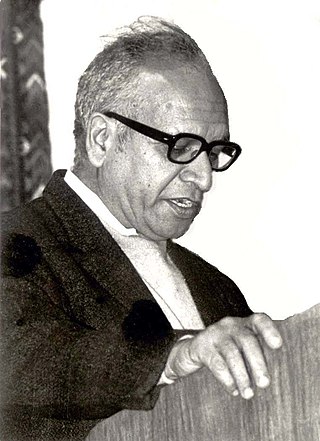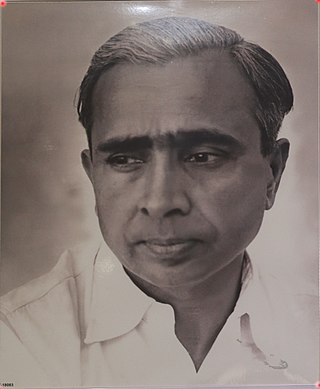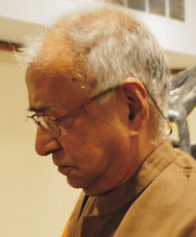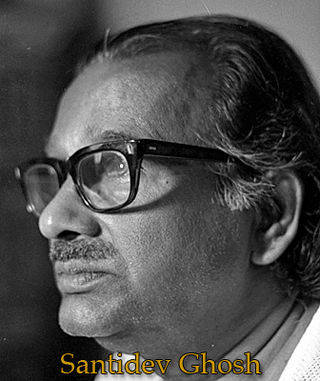Related Research Articles

Hazari Prasad Dwivedi was a Hindi novelist, literary historian, essayist, critic and scholar. He penned numerous novels, collections of essays, historical research on medieval religious movements of India especially Kabir and Natha Sampradaya, and historical outlines of Hindi literature.

Bipan Chandra was an Indian historian, specialising in economic and political history of modern India. An emeritus professor of modern history at Jawaharlal Nehru University, he specialized on the Indian independence movement and is considered a leading scholar on Mahatma Gandhi. He authored several books, including The Rise and Growth of Economic Nationalism.

Visva-Bharati is a public central university and an Institute of National Importance located in Shantiniketan, West Bengal, India. It was founded by Rabindranath Tagore who called it Visva-Bharati, which means the communion of the world with India. Until independence it was a college. Soon after independence, the institution was given the status of a central university in 1951 by an act of the Parliament.

Nandalal Bose was one of the pioneers of modern Indian art and a key figure of Contextual Modernism.

Ramkinkar Baij was an Indian sculptor and painter, one of the pioneers of modern Indian sculpture and a key figure of Contextual Modernism.

Kesava Shankar Pillai, better known as Shankar, was an Indian cartoonist. He is considered the father of political cartooning in India. He founded Shankar's Weekly, India's Punch in 1948. Shankar's Weekly also produced cartoonists like Abu Abraham, Ranga and Kutty, he closed down the magazine during the Emergency of 25 June 1975. From then on he turned to making children laugh and enjoy life.
Sankho Chaudhuri was an Indian sculptor, and a noted figure in the art scene of India. (Although named Naranarain in due family tradition, he was more widely known by his pet name Sankho). Ram Kinker Baij was his teacher. He began close to cubism and then was influenced by István Beöthy, whom he had met in Paris. His themes have included the female figure and wildlife. He has worked in a wide range of media and produced large-scale reliefs and mobiles.

Kalpathi Ganpathi "K.G." Subramanyan was an Indian artist. He was awarded the Padma Vibhushan in 2012.

Santidev Ghose was an Indian author, singer, actor, dancer and maestro of Rabindra Sangeet.

Amiya Chandra Chakravarty (1901–1986) was an Indian literary critic, academic, and Bengali poet. He was a close associate of Rabindranath Tagore, and edited several books of his poetry. He was also an associate of Gandhi, and an expert on the American catholic writer and monk, Thomas Merton. Chakravarty was honoured for his own poetry with the Sahitya Akademi Award in 1963. He taught literature and comparative religion in India for nearly a decade and then for more than two decades at universities in England and the U.S. In 1970, he was honoured by the Government of India with the Padma Bhushan award.
Yukteshwar Kumar is an Indian sinologist, born and brought up in Jagdispur. An alumnus of Jawaharlal Nehru University and Peking University, he taught from 1994 at Visva-Bharati University, Santiniketan, where he obtained his Ph.D. in 2002. Earlier, he also taught at Jawaharlal Nehru University, New Delhi, and worked at All India Radio..

Beohar Rammanohar Sinha was an Indian artist who is very well known for his illustrations in the original final manuscript of Constitution of India, including the complete Preamble-page, which was brought to fruition in 1949 as one of the most beautiful Constitutions in the world in addition to being the most comprehensive one. He is also known as a cultural ambassador of India who disseminated Indian art in the Far East, and brought Oriental Art to India. His works are housed in numerous prestigious public and private collections throughout the world and his murals still adorn the walls and gigantic dome of Jabalpur's historic Shaheed-Smarak or Martyrs'-Memorial Auditorium even after more than half a century, though now demanding conservation.

Sudhir Ranjan Khastgir was an Indian painter of Bengal school of art and an art educator. A pupil of Abanindranath Tagore and Nandalal Bose, Sudhir was known for "Indian style" of painting. He graduated from Visva-Bharati University at Santiniketan in 1929. He was influenced by the Tagore family and his classic works include paintings of scenes from Indian mythologies, women, and village life. He was also the first Art teacher at The Doon School, Dehradun, when it opened in 1935. Today, the many statues and murals on display at Doon, and frescoes of dancers at the entrance of a local cinema hall, 'The Orient', are a product of his creation.

Kala Bhavana is the fine arts faculty of Visva-Bharati University, in Shantiniketan, India. It is an institution of education and research in visual arts, founded in 1919, it was established by Nobel laureate Rabindranath Tagore.
Krishna Kripalani was an Indian freedom fighter, author and parliamentarian. He wrote a number of books on Rabindranath Tagore, Mahatma Gandhi and on Indian literature.
Pratul Chandra Gupta was an Indian historian, writer and the author of Nana Sahib and the Rising at Cawnpore, a historical account of the siege of Cawnpore. Considered by many as an authority on Maratha history, he translated The Maharashta Purana, an 18th-century Bengali text written by Gangaram into English, Edward C. Dimock, a known Indologist, being his co-translator. One of his books, INA in Military Operation, was commissioned by Jawaharlal Nehru but the book could not be published, reportedly due to political objections. The Last Peshwa and the English Commissioners, 1818-1851 and Shah Alam II and His Court are some of his other notable works. The Government of India awarded him the third highest civilian honour of the Padma Bhushan, in 1975, for his contributions to Literature.

Namvar Singh was an Indian literary critic, linguist, academician and theoretician. He received his doctorate degree from Banaras Hindu University where he also taught for some time. He served as a professor of Hindi literature in several other universities. He was the founder and first chairman of Jawaharlal Nehru University's Centre of Indian Languages and continued to remain as a professor emeritus after his retirement in 1992.
The following is a list of notable people associated withVisva- Bharati University and/or Santiniketan, a neighbourhood in Bolpur city in West Bengal, India:

Cheena Bhavana, of Visva-Bharati University, founded in 1937, is a centre of Sino-Indian cultural studies located at Santiniketan in West Bengal, India. Its reputation as a center promoting historical study and modern relations between the two countries was built by such figures as Rabindranath Tagore and Tan Yun-Shan. The library is known for a major collection of Chinese books and journals, especially Buddhist scriptures and texts.
Tan Yun-Shan was a Chinese scholar and founder of Santiniketan's Cheena Bhavana, the oldest centre of Chinese studies in South Asia. He devoted his life to the cause of Sino-Indian cultural friendship.
References
- ↑ Chung Tan (ed.), In the Footsteps of Xuanzang: Tan Yun-shan and India (Gyan Books, 1999; ISBN 8121206308), p. 4.
- ↑ "New Delhi News : A doyen of Chinese cultural studies". The Hindu . Chennai, India. 8 December 2008. Archived from the original on 3 November 2012. Retrieved 2 February 2009.
- ↑ "In the Footsteps of Zuangzang: Tan Yun-Shan and India". Life sketch of Tan Yun-Shan by Tan Lee. Indira Gandhi National Centre for Arts. Retrieved 17 August 2019.
- ↑ Tsui, B. (2010). "The Plea for Asia--Tan Yunshan, Pan-Asianism and Sino-Indian Relations". China Report. 46 (4): 353–370. doi:10.1177/000944551104600403. S2CID 145420931.
- ↑ "THread - the Hindu Blog". The Hindu. Chennai, India.
- ↑ "This Year's Padma Awards announced" (Press release). Ministry of Home Affairs. 25 January 2010. Retrieved 25 January 2010.
- ↑ "Karan Singh turns down China award". ndtv.com. 16 December 2010.
- ↑ "我院授予谭中教授荣誉院士称号" (in Chinese). Yunnan Academy of Social Sciences. 13 June 2013. Retrieved 29 January 2019.
- ↑ Chung, Padma Bhushan Tan (31 July 2018). China: A 5,000-year Odyssey. ISBN 978-9352807246.